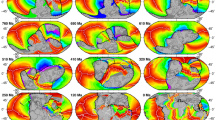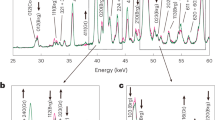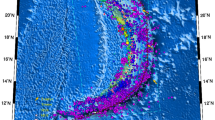Abstract
The linear structures of seismically fast anomalies, often interpreted as subducted slabs, in the southern Asia and circum-Pacific lower mantle provided strong evidence for the whole mantle convection model. However, recent seismic studies have consistently shown that subducted slabs are deflected horizontally for large distances in mantle transition zone in the western Pacific and other subduction zones, suggesting that the slabs meet significant resistance to their descending motion and become stagnant in the transition zone. This poses challenges to the whole mantle convection model and also brings the origin of stagnant slabs into question. Here, using a global mantle convection model with realistic spine–post-spinel phase change (−2 MPa K−1 Clapeyron slope) and plate motion history, we demonstrate that the observed stagnant slabs in the transition zone and other slab structures in the lower mantle can be explained by the presence of a thin, weak layer at the phase change boundary that was suggested by mineral physics and geoid modelling studies. Our study also shows that the stagnant slabs mostly result from subduction in the past 20–30 million years, confirming the transient nature of slab stagnation and phase change dynamics on timescales of tens of millions of years from previous studies.
This is a preview of subscription content, access via your institution
Access options
Access Nature and 54 other Nature Portfolio journals
Get Nature+, our best-value online-access subscription
$29.99 / 30 days
cancel any time
Subscribe to this journal
Receive 12 print issues and online access
$259.00 per year
only $21.58 per issue
Buy this article
- Purchase on Springer Link
- Instant access to full article PDF
Prices may be subject to local taxes which are calculated during checkout




Similar content being viewed by others
Data availability
All of the materials of this study are available on request from the corresponding authors. The S-wave tomography model S40RTS of ref. 9 is available at http://jritsema.earth.lsa.umich.edu//Research.html. The S-wave tomography model SEMUCB_WM1 of ref. 10 is available at http://seismo.berkeley.edu/wiki_br/Main_Page. The P-wave tomography model GAP_P4 of ref. 12 is available at www.godac.jamstec.go.jp/catalog/data_catalog/metadataDisp/GAP_P4?lang=en. The temperature anomalies for Case 4 at present day and the related data are available at https://doi.org/10.6084/m9.figshare.6916256.v1.
References
Dziewonski, A. M. Mapping the lower mantle: determination of lateral heterogeneity in P velocity up to degree and order 6. J. Geophys. Res. Solid Earth 89, 5929–5952 (1984).
Grand, S. P., van der Hilst, R. D. & Widiyantoro, S. Global tomography: a snapshot of convection in the Earth. GSA Today 7, 1–7 (1997).
van der Hilst, R. D., Widiyantoro, S. & Engdahl, E. R. Evidence for deep mantle circulation from global tomography. Nature 386, 578–584 (1997).
Ricard, Y., Richards, M. A., Lithgow-Bertelloni, C. & Le Stunff, Y. A geodynamic model of mantle density heterogeneity. J. Geophys. Res. 98, 21895–21909 (1993).
Lithgow-Bertelloni, C. & Richards, M. A. The dynamics of Cenozoic and Mesozoic plate motions. Rev. Geophys. 36, 27–78 (1998).
Bunge, H. P. et al. Time scales and heterogeneous structure in geodynamic Earth models. Science 280, 91–95 (1998).
Hager, B. H. & Richards, M. A. Long-wavelength variations in Earth’s geoid: physical models and dynamical implications. Phil. Trans. R. Soc. Lond. A 328, 309–327 (1989).
Mitrovica, J. X. & Forte, A. M. A new inference of mantle viscosity based upon joint inversion of convection and glacial isostatic adjustment data. Earth. Planet. Sci. Lett. 225, 177–189 (2004).
Ritsema, J., Deuss, A., Van Heijst, H. J. & Woodhouse, J. H. S40RTS: a degree-40 shear-velocity model for the mantle from new Rayleigh wave dispersion, teleseismic traveltime and normal-mode splitting function measurements. Geophys. J. Int. 184, 1223–1236 (2011).
French, S. W. & Romanowicz, B. A. Broad plumes rooted at the base of the Earth’s mantle beneath major hotspots. Nature 525, 95–99 (2015).
Fukao, Y., Obayashi, M. Nakakuki, T. & Deep Slab Project Group. Stagnant slab: a review. Annu. Rev. Earth. Planet. Sci. 37, 19–46 (2009).
Fukao, Y. & Obayashi, M. Subducted slabs stagnant above, penetrating through, and trapped below the 660 km discontinuity. J. Geophys. Res. Solid Earth 118, 5920–5938 (2013).
Zhao, D., Tian, Y., Lei, J., Liu, L. & Zheng, S. Seismic image and origin of the Changbai intraplate volcano in East Asia: role of big mantle wedge above the stagnant Pacific slab. Phys. Earth Planet. Inter. 173, 197–206 (2009).
Zou, H., Fan, Q. & Yao, Y. U–Th systematics of dispersed young volcanoes in NE China: asthenosphere upwelling caused by piling up and upward thickening of stagnant Pacific slab. Chem. Geol. 255, 134–142 (2008).
Goes, S., Agrusta, R., Van Hunen, J. & Garel, F. Subduction-transition zone interaction: A review. Geosphere 13, 644–664 (2017).
Zhong, S. J. & Gurnis, M. Mantle convection with plates and mobile, faulted plate margins. Science 267, 838–843 (1995).
Christensen, U. R. The influence of trench migration on slab penetration into the lower mantle. Earth. Planet. Sci. Lett. 140, 27–39 (1996).
Agrusta, R., Goes, S. & van Hunen, J. Subducting-slab transition-zone interaction: Stagnation, penetration and mode switches. Earth. Planet. Sci. Lett. 464, 10–23 (2017).
Christensen, U. R. & Yuen, D. A. Layered convection induced by phase transitions. J. Geophys. Res. Solid Earth 90, 10291–10300 (1985).
Tackley, P. J., Stevenson, D. J., Glatzmaier, G. A. & Schubert, G. Effects of an endothermic phase transition at 670 km depth in a spherical model of convection in the Earth’s mantle. Nature 361, 699–704 (1993).
Ita, J. & King, S. D. The influence of thermodynamic formulation on simulations of subduction zone geometry and history. Geophys. Res. Lett. 25, 1463–1466 (1998).
van der Hilst, R. & Seno, T. Effects of relative plate motion on the deep structure and penetration depth of slabs below the Izu-Bonin and Mariana island arcs. Earth. Planet. Sci. Lett. 120, 395–407 (1993).
Yang, T. et al. Cenozoic lithospheric deformation in Northeast Asia and the rapidly-aging Pacific Plate. Earth. Planet. Sci. Lett. 492, 1–11 (2018).
Gurnis, M. & Hager, B. H. Controls of the structure of subducted slabs. Nature 335, 317–321 (1988).
Garel, F. et al. Interaction of subducted slabs with the mantle transition-zone: a regime diagram from 2-D thermos-mechanical models with a mobile trench and an overriding plate. Geochem. Geophys. Geosyst. 15, 1739–1765 (2014).
Zhong, S. J. & Gurnis, M. Role of plates and temperature‐dependent viscosity in phase change dynamics. J. Geophys. Res. Solid Earth 99, 15903–15917 (1994).
Čı́žková, H., van Hunen, J., van den Berg, A. P. & Vlaar, N. J. The influence of rheological weakening and yield stress on the interaction of slabs with the 670 km discontinuity. Earth. Planet. Sci. Lett. 199, 447–457 (2002).
Billen, M. I. & Hirth, G. Rheologic controls on slab dynamics. Geochem. Geophys. Geosyst. 8, Q08012 (2007).
King, S. D., Frost, D. J. & Rubie, D. C. Why cold slabs stagnate in the transition zone. Geology 43, 231–234 (2015).
Katsura, T. et al. Post-spinel transition in Mg2SiO4 determined by high P–T in situ X-ray diffractometry. Phys. Earth Planet. Inter. 136, 11–24 (2003).
Fei, Y. et al. Experimentally determined postspinel transformation boundary in Mg2SiO4 using MgO as an internal pressure standard and its geophysical implications. J. Geophys. Res. Solid Earth 109, B02305 (2004).
Litasov, K. D., Ohtani, E., Sano, A., Suzuki, A. & Funakoshi, K. Wet subduction versus cold subduction. Geophys. Res. Lett. 32, L13312 (2005).
Seton, M. et al. Global continental and ocean basin reconstructions since 200 Ma. Earth Sci. Rev. 113, 212–270 (2012).
Leng, W. & Zhong, S. J. Controls on plume heat flux and plume excess temperature. J. Geophys. Res. Solid Earth 113, B04408 (2008).
Turcotte, D. L. & Schubert, G. (eds) Geodynamics 3rd edn 192–193 (Cambridge Univ. Press, Cambridge, 2014).
Müller, R. D., Dutkiewicz, A., Seton, M. & Gaina, C. Seawater chemistry driven by supercontinent assembly, breakup, and dispersal. Geology 41, 907–910 (2013).
Zhong, S. J. & Rudolph, M. L. On the temporal evolution of long-wavelength mantle structure of the Earth mantle since the Early Paleozoic. Geochem. Geophys. Geosyst. 16, 1599–1615 (2015).
Hassan, R., Müller, R. D., Gurnis, M., Williams, S. E. & Flament, N. A rapid burst in hotspot motion through the interaction of tectonics and deep mantle flow. Nature 533, 239–242 (2016).
Karato, S. I. Deformation of Earth Materials: An Introduction to the Rheology of Solid Earth (Cambridge Univ. Press, Cambridge, 2008).
Panasyuk, S. V. & Hager, B. H. A model of transformational superplasticity in the upper mantle. Geophys. J. Int. 133, 741–755 (1998).
Čížková, H. & Bina, C. R. Effects of mantle and subduction-interface rheologies on slab stagnation and trench rollback. Earth. Planet. Sci. Lett. 379, 95–103 (2013).
Nakakuki, T., Tagawa, M. & Iwase, Y. Dynamical mechanisms controlling formation and avalanche of a stagnant slab. Phys. Earth Planet. Inter. 183, 309–320 (2010).
Bercovici, D. The generation of plate tectonics frommantle convection. Earth. Planet. Sci. Lett. 205, 107–121 (2003).
Zhong, S. J. & Watts, A. B. Lithospheric deformation induced by loading of the Hawaiian Islands and its implications for mantle rheology. J. Geophys. Res. 118, 6025–6048 (2013).
Kohlstedt, D. L. & Mackwell, S. J. in Planetary Tectonics (eds Waters, T. & Schultz, R.) 395–455 (Cambridge Univ. Press, New York, 2009).
Bunge, H. P. & Grand, S. P. Mesozoic plate-motion history below the northeast Pacific Ocean from seismic images of the subducted Farallon slab. Nature 405, 337–340 (2000).
Liu, L., Spasojević, S. & Gurnis, M. Reconstructing Farallon plate subduction beneath North America back to the Late Cretaceous. Science 322, 934–938 (2008).
Jolivet, L., Tamaki, K. & Fournier, M. Japan Sea, opening history and mechanism: a synthesis. J. Geophys. Res. 99, 22237–22259 (1994).
Lee, C. & King, S. D. Dynamic buckling of subducting slabs reconciles geological and geophysical observations. Earth. Planet. Sci. Lett. 312, 360–370 (2011).
Zhong, S. J., McNamara, A., Tan, E., Moresi, L. & Gurnis, M. A benchmark study on mantle convection in a 3‐D spherical shell using CitcomS. Geochem. Geophys. Geosyst. 9, Q10017 (2008).
King, S. D. Radial models of mantle viscosity: results from a genetic algorithm. Geophys. J. Int. 122, 725–734 (1995).
Rudolph, M. L., Lekić, V. & Lithgow-Bertelloni, C. Viscosity jump in Earth’s mid-mantle. Science 350, 1349–1352 (2015).
Zhong, S. J., Zuber, M. T., Moresi, L. & Gurnis, M. Role of temperature‐dependent viscosity and surface plates in spherical shell models of mantle convection. J. Geophys. Res. Solid Earth 105, 11063–11082 (2000).
Li, M. et al. Quantifying melt production and degassing rate at mid-ocean ridges from global mantle convection models with plate motion history. Geochem. Geophys. Geosyst. 17, 2884–2904 (2016).
Acknowledgements
We thank S. Goes and S. King for helpful comments on the manuscript. The work is supported by National Science Foundation through grant numbers 1135382, 1645245 and 1450181.
Author information
Authors and Affiliations
Contributions
W.M. and S.J.Z. developed the concept of the project, designed models, developed the analysis methods and wrote the paper. W.M. performed the calculations.
Corresponding authors
Ethics declarations
Competing interests
The authors declare no competing interests.
Additional information
Publisher’s note: Springer Nature remains neutral with regard to jurisdictional claims in published maps and institutional affiliations.
Supplementary information
Supplementary Information
Supplementary Discussion, Supplementary Figures 1–11, Supplementary Tables 1 and 2.
Rights and permissions
About this article
Cite this article
Mao, W., Zhong, S. Slab stagnation due to a reduced viscosity layer beneath the mantle transition zone. Nature Geosci 11, 876–881 (2018). https://doi.org/10.1038/s41561-018-0225-2
Received:
Accepted:
Published:
Issue Date:
DOI: https://doi.org/10.1038/s41561-018-0225-2
This article is cited by
-
Weak upper-mantle base revealed by postseismic deformation of a deep earthquake
Nature (2023)
-
Remnant of the late Permian superplume that generated the Siberian Traps inferred from geomagnetic data
Nature Communications (2023)
-
Kimberlite eruptions driven by slab flux and subduction angle
Scientific Reports (2023)
-
Deconstructing plate tectonic reconstructions
Nature Reviews Earth & Environment (2023)
-
Possible South-Dipping Mesozoic Subduction at Southern Tethys Ocean-Constrained from Global Tectonic Reconstructions and Seismic Tomography
Journal of Earth Science (2023)



